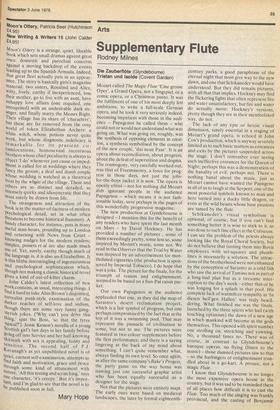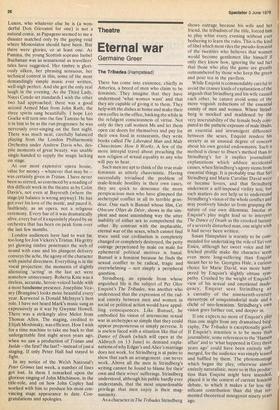Arts
Supplementary Flute
Rodney Milnes
Die Zauberflote (Glyndebourne) Tristan und 'wide (Covent Garden)
Mozart called The Magic Flute 'Eine grosse Oper', a Grand Opera, not a Singspiel, or a comic opera, or a Christmas panto. It was the fulfilment of one of his most deeply felt ambitions, to write a full-Scale German opera, and he took it very seriously indeed, becoming impatient with those in the audience — Papagenos he called them — who could not or would not understand what was going on. What was going on, roughly, was the synthesis of opposing elements in creation, a synthesis symbolised by the concept of the new couple, 'clas neue Paar'. It is an opera about reconciliation, about progress, about the defeat of superstition and dogma. The cosmogony, very carefully worked out, was that of Freemasonry, a force for progress in those days, not just the jobsfor-the-boys racket it is now. The opera is openly elitist — not for nothing did Mozart dub ignorant people in the audience Papagenos — which means it is not fashionable today, save perhaps in the pages of this wonderfully progressive magazine.
The new production at Gyndebourne is designed — I mention this for the benefit of any readers who have spent the last month on Mars — by David Hockney. He has provided a number of .pictures , some of them exceedingly pretty, some less so, some inspired by Mozart's music, some not. We read in the Observer that the Trial by Water was inspired by an advertisement for mentholated cigarettes (the production is sponsored by Imperial Tobacco). I do hope that was a joke. The picture for the finale, for the triumph of reason and enlightenment, seemed to be based on a Sun-Pat raisin packet.
Our own Papagenos in the audience applauded that one, as they did the map of Sarastro's desert reclamation project, which is a fair symbol of progress, but one perhaps compromised by the fact that at the top of it was a swimming pool. That may represent the pinnacle of civilisation to some, but not to me. The pictures were featured in two colour supplements before the first performance, and there is a saying lingering at the back of my mind about something, I can't quite remember what, always finding its own level. So once again, as after the same company's Rake's Pro gess, the party game on the way home was naming just one successful graphic artist who has been equally successful as a designer for the stage.
Not that the pictures were entirely inapt. The early ones were based on medieval landscapes, the later by formal eighteenth
century parks, a good paraphrase of the eternal night that must give way to the new dawn, and one that Schikaneder would have understood. But they did remain pictures, with all that that implies. Hockney may find the flickering lights that often represent fire and water unsatisfactory, but fire and water do actually move: Hockney's versions, pretty though they are in their mentholated way, do not.
• The lack of any epic or heroic visual dimension, surely essential in a staging of Mozart's grand opera, is echoed in John Cox's production, which is anyway severely limited as to such basic matters as entrances and exits by the pictures suspended across the stage. I don't remember ever seeing such ineffective entrances for the Queen of Night; perhaps this was a demonstration of the banality of evil; perhaps not. There is nothing banal about the music, just as Mozart cannot have wanted the Papageno in all of us to laugh at the Serpent, one of the most powerful symbols known to man and here turned into a ducky little dragon, or even at the wild beasts whose base passions are tamed by the flute.
Schikaneder's visual symbolism is optional, of course, but if you can't find something better it is wise to stick to it, as was done to such fine effect at the Coliseum. I can see the problem of the priests always looking like the Royal Choral Society, but do not believe that turning them into Bovis employees with set-squares and plumblines is necessarily a solution. The attractions of the brotherhood were not enhanced by the conception of Sarastro as a cold fish who saw the arrival of Tam ino not as part of a long-laid plan but as a tiresome interruption to the day's work —either that or he was longing for a splash in that pool. His complete lack of warmth or sympathy in 'In diesen heil'gen Hallen' was truly bewildering. What finished me was the finale, launched by the three spirits who hail (with touching optimism) the dawn of a new age in which mankind will become as the gods themselves. This opened with spirit number one strolling on, stretching and yawning. No, a thousand times no. There was of course, in contrast to Glyndebourne's baroque operas, no flying (listen to the music) — those damned pictures saw to that — so the harbingers of enlightenment trundled about in a go-kart. A prosaic, not a magic Flute.
I know that Glyndebourne is no longer the most expensive opera house in the country, but it was sad to be reminded there of all places how difficult it is to cast the Flute. Too much of the singing was frankly provincial, and the casting of Benjamin
Luxon, who whatever else he is (a wonderful Don Giovanni for one) is not a natural comic, as Papageno seemed tome a disaster matched only by the gaping void where Monostatos should have been. But there were glories, or at least one. As Pamina, the young Scottish soprano Isobel Buchanan was as sensational as travellers' tales have suggested. Her timbre is gloriously silken, her phrasing sensuous, her technical control in this, some of the most demandingly simple music ever written, well-nigh perfect. And she got the only real laugh in the evening. As the Third Lady, Nucci Condo set standards I wish the other two had approached; there was a good second Armed Man from John Rath; the three spirits sang beautifully. I hope Leo Goeke will turn into the fine Tam ino he has it in him to be as the run progresses: he was nervously over-singing on the first night. There was much neat, carefully balanced playing from the London Philharmonic Orchestra under Andrew Davis who, despite moments of great beauty, was unable single-handed to supply the magic lacking on stage.
At our most exgensive opera house, value for money whatever that may be was certainly given in Tristan. I have never been so stirred, so convinced by a reading of this difficult work in the theatre as by Colin Davis's, not even at Bayreuth (where the stage/pit balance is wrong anyway). He has got over his love of the music, and paced it, faultlessly, as an opera, not a religious ceremony. Every bar of it was dramatically alive, every bar of it exquisitely played by an orchestra that has been on peak form over the last few months.
London audiences have had to wait tar too long for Jon Vickers's Tristan. His gritty yet glowing timbre penetrates the web of sound with ease and his plangent delivery conveys the ache, the agony of the character with painful directness. Everything is in the vocal projection: the moments of slightly
alienating 'acting' in the last act were somehow unnecessary. Roberta Knie was a tireless, accurate, heroic-voiced Isolde with a most handsome presence. Josephine Vea-1
sey (Brangtine) looks more beautiful every year. Kurwenal is Donald McIntyre's best role. I have not heard Mark's music sung as expressively as it was by Gwynne Howell. There was a strikingly alive Melot from Thomas Allen. The staging, credited to Elijah Moshinsky, was efficient. How I wish for a time machine to take me back to that unforgettable first night seyen years ago, when we saw a production of Tristan und Isolde the firserthe last? -instead of just a: staging. If only Peter Hall had stayed to fight.
In my notice of the Welsh National's Peter Grimes last week, a number of lines got lost. In them I remarked upon the glorious singing of John Mitchinson, in the title-role, and on how John Copley had worked with him to produce his most convincing stage appearance to date. Congratulations and apologies.



































 Previous page
Previous page